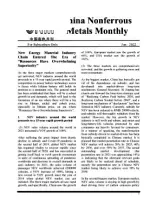Favorable Policies for Copper Imported processing trade Formulated
2012-08-15
The Ministry of Finance and State Administration of Taxation issued “Circular about the Value-added Tax (VAT) and Consumption Tax Policies on Export Goods and Labor Services” (Caishui〔2012〕No.39) in September, indicating that the imported processing trade policy related to copper concentrate changed again. As a result, export taxes on refined copper have been significantly reduced,and smelters’ enthusiasm has been aroused.
Under the general term of trade, value-added tax, which accounts for 17% of the total price,shall be paid for import of copper concentrate.Moreover, in the subsequent export of refined copper, a tariff shall be imposed for high-purity or other cathode copper by 5% or 10%. Therefore, under the general term of trade, if a smelter purchases copper concentrate and processes such copper concentrate into refined copper for export, it has to pay high taxes.
While imported processing trade differs from the import of copper concentrate under general term of trade in terms of tax imposition. In 2012, the taxation mode of copper concentrate imported processing trade has turned from imposition of payable tax by 3% of FOB for export goods to the tax imposition mode of linking up with the applicable tax rate (17%).
“This results in reduction of payable tax on copper concentrate imported processing trade by approximately 76%.” Zhang Ao, a metal future researcher of Minmetals, said. According to the tax imposition plan, the payable tax on supplied and imported processing trade of copper concentrate will be significantly reduced in the process of export. “The computation mode of tax amount will actually equate export and domestic trade”.
Besides the good news brought by the lowered export tariff rate, imported processing trade itself remains an advantageous position in terms of price ratio. “The SHFE/LME price ratio remains sluggish in 2012. Take import of refined copper under the general term of trade for example, the loss even reached RMB 4,000/ton in May. By contrast, since both import of copper concentrate and re-export of refined copper are settled on the basis of US dollar, the profit of processing with imported materials, in theory, does not relate to domestic/overseas price ratio, thus reducing enterprises’ loss on price ratio.” Zhang noted.
Tao Yang, Vice General Manger of Minmetals Futures Co’,Ltd, believes that, if the price ratio is inappropriate, smelters have to bear higher opportunity cost in carrying out general copper concentrate trade. “Under the circumstance of significant loss of imports, imported processing trade can avoid price ratio loss, and the payable tax can be reduced significantly at present. It is estimated that smelters will pay more attention to such trade”.
The reporter learnt in the interview that the reexported refined copper through processing with imported materials is not necessarily delivered to LME’s warehouse in Asia, but can be sold directly to the bonded area outside the customs. Therefore, some market insiders believe that although this seemingly increases invisible inventory of the bonded area, in nature, it transfers the refined copper inventory inside the customs beyond the customs, and the bonded area provides export of domestic refined copper with a relatively convenient channel.
“Re-export of finished products with imported processing trade will reduce domestic trade volume, and the high-speed growth of refined copper export is likely to squeeze domestic refined copper supply. Such a high-speed export growth within a certain period will inevitably make an impact on the spot market of refined copper, thus benefiting domestic copper price.”Tao Yang considered that the policy’s influence on the market will appear gradually in the future.
杂志排行
China Nonferrous Metals Monthly的其它文章
- Amer International Group to Complete a 500,000-Ton Refined Copper Project in 2015
- Laizhou to Build the World’s Largest Gold Industrial Base
- Guangdong to Build Rare Earth Deep Processing Industry Chain
- Wenshan’s 800,000-ton Alumina Project Completed
- Hunan Rare Earth Group Approved
- Henan’s 80% Aluminum Enterprises Remains in the Red
